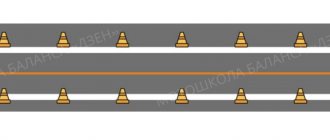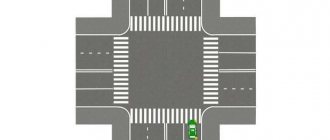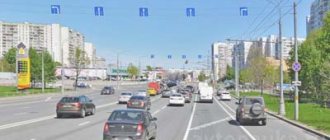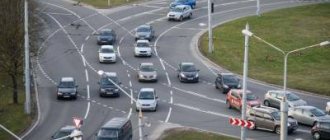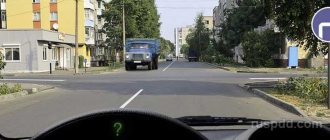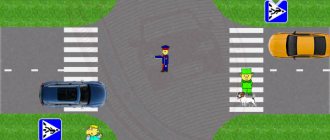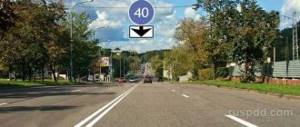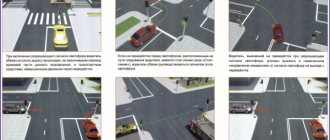Crossing a roundabout causes difficulties not only for beginners, but also for experienced drivers. Not everyone knows the rules according to which you need to pass the “ring”. Many act intuitively or repeat the mistakes of others, copying their maneuvers. Intersections of this type are considered low-risk, but the number of accidents at them has recently been growing rapidly. How to avoid problems on the road?
Distinctive features of roundabouts
Most traffic accidents focus on at-grade intersections of highways. The throughput in such areas is always very difficult, and the speed of the vehicles is low. To reduce the risk of accidents, roundabouts are being created. They represent intersections at one level, usually in the form of a circle with an “island” in the center. Traffic moves counterclockwise.
Due to the circular structure of the intersection, the intersection of traffic flows is eliminated. First they merge, then they branch out without interfering with other participants. The traffic rules do not have a clear definition of such an intersection, but the rules spell out all the features of entry and exit from the ring roadway.
Roundabout sign
Before an intersection where a roundabout is organized, 50-100 meters in a populated area and 150-300 meters outside a populated area, a warning sign 1.7 “Intersection with a roundabout” is installed.
Directly before the intersection, a mandatory sign 4.3 “Roundabout” is installed, which obliges us to move in the direction of the arrows.
On our roads, traffic around a roundabout is carried out only counterclockwise, since in Russia traffic is organized on the right.
Priority signs with the direction of the main road may also be installed. If there are no priority signs when entering an intersection where there is a roundabout and which is marked with sign 4.3, the driver of the vehicle is obliged to give way to vehicles moving along such an intersection.
Entrance to the "ring"
Sign 4.3 Circular traffic indicates that you are entering a “ring”. It differs from a regular intersection in that vehicles moving along the ring roadway always have priority. You can travel from any lane. When changing lanes and exiting, the right turn signal is always turned on. Many drivers make a mistake and turn on the left turn signal - but this contradicts not only traffic rules, but also logic. You must turn into the far right lane, unless otherwise indicated by signs or markings.
In heavy traffic, there will likely be other vehicles on the right. You should drive along the “ring” in such a way as not to interfere with them. A “Lane Drive” sign may be installed in front of the intersection. In this case, you must follow the traffic rules, otherwise you may receive a fine.
Which turn signal to turn on when entering a traffic circle?
Experienced drivers, especially in heavy traffic, always turn on the right turn signal if they want to enter the roundabout and take the next branch to the right. Those who want to drive straight through the roundabout or go left always turn on the left turn signal so that all road users can see that the driver does not want to move in the far right lane.
No matter how much I searched, I could not find the algorithm of actions in the modern edition, but I found an episode in one of the television programs where the responsible traffic police officer of Samara, Chugunov, pointed out that when entering a roundabout, the driver must turn on the right turn signal , because . no one goes to the left, that means right.
I personally do not agree with this opinion and turn on the left turn signal when entering a roundabout if I am going to drive straight through it or go left.
But, no one asks my opinion on the question of which turn signal to turn on when entering a roundabout, so we turn on the DDD rule (give way to the fool) and remember that when entering the roundabout it is necessary to turn on the right turn signal in advance.
Exit from the "ring"
Unlike entering, exiting must only be done from the far right lane. If otherwise is not provided by signs installed on the road, then you must also move into the far right lane. And it doesn’t matter how many lanes there are on the roadway. You can change lanes only after leaving the roundabout, acting strictly within the framework of traffic rules. This factor often becomes the cause of accidents, since drivers do not know the rules or deliberately ignore them and drive on the part of the road where it is convenient.
You must drive through a roundabout without stopping, otherwise there is a risk of creating a traffic jam. This can happen if you did not have time to change lanes to the far right to exit. In this case, you need to make one circle and move in advance to where you should go.
How to use turn signals in a roundabout
Traffic rules are the most painful issue for most motorists. After driving school, it seems that you get behind the wheel and drive like a law-abiding citizen, but after a couple of months you forget what turn signals and a red traffic light are. Sooner or later, the rules laid down at the initial stage begin to go away. But the authorities are not asleep. Well aware of these statistics, they introduce new rules and harsher penalties for those who do not comply with them.
Recently, there has been a strange trend - drivers in Russia are becoming more polite on the road, or trying to seem so. The emergency alarm button began to be used with great frequency. This way you can not only thank the other driver for giving way, but also warn that there is an ambush ahead in the form of traffic police officers. To be honest, even turn signals are being used much more often than 10 years ago. True, they learned how to use it, but not everyone was able to remember how and when to use turn signals. To study this problem in detail and find solutions, let's consider the most problematic situation that you can encounter on the road - roundabouts. Here, all motorists begin to blink as anyone wants and no one wonders whether he is doing the right thing.
To more accurately understand the mechanism of entering a roundabout, you should always imagine that you are moving along a winding road. We don’t turn on the turn signal as soon as we repeat the trajectory of the road using the steering wheel. Exactly the same rule must be followed when driving on the ring. If the road has two lanes, then access to it is allowed from both lanes. At the same time, there is no need to blink the turn signal at all. On the territory of the Russian Federation, roundabout traffic is organized counterclockwise, and the circle itself acts as the main road. In fact, this is a continuation of the road along which traffic moved before entering the ring. Some tricks may await the motorist in the circle itself. If there are 2 lanes on the road, and at the roundabout you need to immediately turn right, you need to occupy the far right lane and drive in the far right lane at the roundabout. When the vehicle is already located on the circle, it is necessary to indicate to other road users your intention to make a turn.
If you need to turn on the next segment, you should initially occupy the left lane. When approaching the turning point, you should turn on the right turn signal and move into the far right lane. In the Traffic Rules there is no specific standard for the interval when the sign needs to be turned on. However, every motorist must warn other road users about performing the maneuver in advance in order to prevent the occurrence of a traffic accident. As you can see, you don’t need to remember any complex rules when driving through a roundabout - everything is very clear and transparent. The main thing to remember is that turn signals are needed to indicate which road you are taking at an intersection. If the signs in the car do not work, you need to give signals using your hands - as they teach in a driving school.
Bottom line . Turn signals in a car are needed to show other road users your intention to perform a particular maneuver. Despite this, not all motorists today use them correctly.
Driving through a roundabout during the traffic police exam
At the traffic police exam, where students demonstrate the ability to drive around the city, observing traffic rules, it is often necessary to pass the “ring”. Don't be nervous, if you do everything correctly, no problems will arise:
- Shortly before entering the intersection, take the extreme right position on the road (change from another lane, if necessary).
- Turn on the right turn signal.
- When driving cars around the ring, let each of them pass, since the ring road is the main one.
- When the path is clear, enter the roundabout, keeping to the right, and turn off the right turn signal.
- Before leaving the roundabout, turn on your turn signal again and exit the intersection in the right lane.
- Turn off the right turn signal.
Even if there are 3 or more roads adjacent to the ring, you can go to any of them using the simple instructions outlined above. The main thing is to move without stopping, at a moderate speed, in accordance with the rules of the road.
If you ignore traffic rules and drive as you please, you can not only get a fine, but also become involved in an accident. If you maneuver incorrectly, you risk creating an obstacle for other cars and becoming an obstacle on the road. Be careful and responsible.
Comments
Website (4) Facebook (0) Odnoklassniki (0)
4
24.09.2013, 04:57
Che, this is not a rebuild! This is driving straight down the lane! Do not mislead other road users with your ignorance!
— Car enthusiast (guest)
3
24.09.2013, 04:53
wrong. and in general, any change of lane without a turn signal is misleading to other drivers. nonsense in short and a contradiction to traffic rules
— Che (guest)
2
20.09.2013, 03:01
Everything is written normally, when entering, if you do not change lanes, you do not need to turn on the turn, and when leaving, with a right turn indicator, you inform those entering the roundabout that you are leaving the roundabout at the next turn and they should not interfere and cut off, that’s all.
A turn signal when entering a roundabout informs about a lane change on the roundabout itself, and not about the fact of entering it.
—Saint (guest)
1
19.09.2013, 06:08
When I took my license, the theory teacher and driving instructor clearly conveyed to us that we should enter the roundabout with a right turn, then turn off the turn and turn on the right turn again before leaving. Everything is clear and understandable. The order given in the article, it seems to me, only confuses traffic participants, even if it does not contradict the traffic rules.
— truthist555
There are no comments yet
There are no comments yet
Preparing to leave the intersection
In previous articles, the following principles for driving roundabouts were defined:
- You should drive exclusively counterclockwise.
- It is rational to drive through the intersection in the far right lane.
If you use the second principle, then leaving the roundabout should not cause any problems.
If you prefer to drive in the central lanes, then before leaving the roundabout you must additionally change lanes to the far right lane, because according to paragraph 8.5 of the traffic rules:
8.5. Before turning right, left or making a U-turn, the driver is obliged to take in advance the appropriate extreme position on the roadway intended for traffic in this direction, except in cases where a turn is made when entering an intersection where a roundabout is organized.
When rebuilding, the following rules must be observed:
1. Turn on the turn signal.
8.1. Before starting to move, change lanes, turn (U-turn) and stop, the driver is required to give signals with turn signals in the appropriate direction, and if they are missing or faulty, with his hand. In this case, the maneuver must be safe and not interfere with other road users.
2. Give way to cars driving in the lane you need to change lanes into.
3. Give way to cars that are changing lanes into “your” lane.
8.4. When changing lanes, the driver must give way to vehicles moving in the same direction without changing direction. When simultaneously changing lanes of vehicles moving in the same direction, the driver must give way to the vehicle on the right.


